Evaluation of the Combination of Muscle Energy Technique and Trigger Point Therapy in Asymptomatic Individuals with a Latent Trigger Point
Abstract
1. Introduction
2. Materials and Methods
2.1. Study Design
2.2. Participants
2.3. Measurement Methods
2.3.1. Goniometry of the Cervical Spine
2.3.2. Pressure Pain Threshold (PPT)
2.4. Therapeutic Interventions
2.4.1. Muscle Energy Technique (MET)
2.4.2. Trigger Point Therapy (TPT)
2.4.3. Combination of MET and TPT
2.5. Statistical Methods
3. Results
3.1. Cervical Range of Motion (CROM)
3.2. Pressure Pain Threshold (PPT)
4. Discussion
4.1. Range of Motion
4.2. Pressure Pain Threshold (PPT)
4.3. Combination of Different Therapeutic Methods
4.4. Research Limitations and Suggestions for Future Studies
5. Conclusions
Author Contributions
Funding
Acknowledgments
Conflicts of Interest
References
- Fryer, G. Muscle energy technique: An evidence-informed approach. Int. J. Osteopath. Med. 2011, 14, 3–9. [Google Scholar] [CrossRef]
- Nagrale, A.V.; Glynn, P.; Joshi, A.; Ramteke, G. The efficacy of an integrated neuromuscular inhibition technique on upper trapezius trigger points in subjects with non-specific neck pain: A randomized controlled trial. J. Man. Manip. Ther. 2010, 18, 37–43. [Google Scholar] [CrossRef] [PubMed]
- Moore, S.D.; Laudner, K.G.; McLoda, T.A.; Shaffer, M.A. The immediate effects of muscle energy technique on posterior shoulder tightness: A randomized controlled trial. J. Orthop. Sports Phys. Ther. 2011, 41, 400–407. [Google Scholar] [CrossRef] [PubMed]
- García-Peñalver, U.J.; Palop-Montoro, M.V.; Manzano-Sánchez, D. Effectiveness of the Muscle Energy Technique versus Osteopathic Manipulation in the Treatment of Sacroiliac Joint Dysfunction in Athletes. Int. J. Environ. Res. Public Health. 2020, 17, 4490. [Google Scholar] [CrossRef] [PubMed]
- Smith, M.; Fryer, G. A Comparison of two muscle energy techniques for increasing flexibility of the hamstring muscle group. J. Bodyw. Mov. Ther. 2008, 12, 312–317. [Google Scholar] [CrossRef] [PubMed]
- Rauseo, C. The rehabilitation of a runner with iliopsoas tendinopathy using an eccentric-biased exercise-a case report. Int. J. Sports Phys. Ther. 2017, 12, 1150–1162. [Google Scholar] [CrossRef]
- Day, J.M.; Nitz, A.J. The effect of muscle energy techniques on disability and pain scores in individuals with low back pain. J. Sport. Rehabil. 2012, 21, 194–198. [Google Scholar] [CrossRef]
- Phadke, A.; Bedekar, N.; Shyam, A.; Sancheti, P. Effect of muscle energy technique and static stretching on pain and functional disability in patients with mechanical neck pain: A randomized controlled trial. Hong Kong Physiother. J. 2016, 35, 5–11. [Google Scholar] [CrossRef]
- Franke, H.; Fryer, G.; Ostelo, R.W.J.G.; Kamper, S.J. Muscle energy technique for non-specific low-back pain. A Cochrane systematic review. Int. J. Osteopath. Med. 2016, 20, 41–52. [Google Scholar] [CrossRef]
- Falsiroli Maistrello, L.; Geri, T.; Gianola, S.; Zaninetti, M.; Testa, M. Effectiveness of Trigger Point Manual Treatment on the Frequency, Intensity, and Duration of Attacks in Primary Headaches: A Systematic Review and Meta-Analysis of Randomized Controlled Trials. Front. Neurol. 2018, 9, 254. [Google Scholar] [CrossRef]
- Lopez-Martos, R.; Gonzalez-Perez, L.M.; Ruiz-Canela-Mendez, P.; Urresti-Lopez, F.J.; Gutierrez-Perez, J.L.; Infante-Cossio, P. Randomized, double-blind study comparing percutaneous electrolysis and dry needling for the management of temporomandibular myofascial pain. Med. Oral Patol. Oral Cir. Bucal 2018, 23, e454–e462. [Google Scholar] [CrossRef] [PubMed]
- Zhou, J.Y.; Wang, D. An update on botulinum toxin A injections of trigger points for myofascial pain. Curr. Pain Headache Rep. 2014, 18, 386. [Google Scholar] [CrossRef] [PubMed]
- Affaitati, G.; Costantini, R.; Tana, C.; Lapenna, D.; Schiavone, C.; Cipollone, F.; Giamberardino, M.A. Effects of topical vs injection treatment of cervical myofascial trigger points on headache symptoms in migraine patients: A retrospective analysis. J. Headache Pain 2018, 19, 104. [Google Scholar] [CrossRef] [PubMed]
- Celik, D.; Mutlu, E.K. Clinical implication of latent myofascial trigger point. Curr. Pain Headache Rep. 2013, 17, 353. [Google Scholar] [CrossRef]
- Vernon, H.; Schneider, M. Chiropractic management of myofascial trigger points and myofascial pain syndrome: A systematic review of the literature. J. Manip. Physiol. Ther. 2009, 32, 14–24. [Google Scholar] [CrossRef] [PubMed]
- Abbaszadeh-Amirdehi, M.; Ansari, N.N.; Naghdi, S.; Olyaei, G.; Nourbakhsh, M.R. Neurophysiological and clinical effects of dry needling in patients with upper trapezius myofascial trigger points. J. Bodyw. Mov. Ther. 2017, 21, 48–52. [Google Scholar] [CrossRef] [PubMed]
- Gerber, L.H.; Sikdar, S.; Armstrong, K.; Diao, G.; Heimur, J.; Kopecky, J.; Turo, D.; Otto, P.; Gebreab, T.; Shah, J. A systematic comparison between subjects with no pain and pain associated with active myofascial trigger points. PM R 2013, 5, 931–938. [Google Scholar] [CrossRef]
- Muñoz-Muñoz, S.; Muñoz-García, M.T.; Alburquerque-Sendín, F.; Arroyo-Morales, M.; Fernández-de-las-Peñas, C. Myofascial trigger points, pain, disability, and sleep quality in individuals with mechanical neck pain. J. Manip. Physiol. Ther. 2012, 35, 608–613. [Google Scholar] [CrossRef]
- Clark, B.C.; Thomas, J.S.; Walkowski, S.A.; Howell, J.N. The biology of manual therapies. J. Am. Osteopath. Assoc. 2012, 112, 617–629. [Google Scholar]
- Huguenin, L.K. Myofascial trigger points: The current evidence. Phys. Ther. Sport 2004, 5, 2–12. [Google Scholar] [CrossRef]
- Giamberardino, M.A.; Affaitati, G.; Fabrizio, A.; Costantini, R. Myofascial pain syndromes and their evaluation. Best Pract. Res. Clin. Rheumatol. 2011, 25, 185–198. [Google Scholar] [CrossRef] [PubMed]
- Kuan, T.S. Current studies on myofascial pain syndrome. Curr. Pain Headache Rep. 2009, 13, 365–369. [Google Scholar] [CrossRef] [PubMed]
- Chang, C.W.; Chang, K.Y.; Chen, Y.R.; Kuo, P.L. Electrophysiologic evidence of spinal accessory neuropathy in patients with cervical myofascial pain syndrome. Arch. Phys. Med. Rehabil. 2011, 92, 935–940. [Google Scholar] [CrossRef] [PubMed]
- Hamilton, L.; Boswell, C.; Fryer, G. The effects of high-velocity, low-amplitude manipulation and muscle energy technique on suboccipital tenderness. Int. J. Osteopath. Med. 2007, 10, 42–49. [Google Scholar] [CrossRef]
- Pattanshetty, R.B.; Raikar, A.S. Immediate effect of three soft tissue manipulation techniques on pain response and flexibility in chronic plantar fasciitis: A randomized clinical trial. Int. J. Physiother. Res. 2015, 3, 875–884. [Google Scholar] [CrossRef]
- Mohammadi Kojidi, M.; Okhovatian, F.; Rahimi, A.; Baghban, A.A.; Azimi, H. The influence of positional release therapy on the myofascial trigger points of the upper trapezius muscle in computer users. J. Bodyw. Mov. Ther. 2016, 20, 767–773. [Google Scholar] [CrossRef]
- Ali, S.; Ahmad, S.; Jalal, Y.; Shah, B. Effectiveness of stretching exercises versus muscle energy techniques in the management of upper cross syndrome. JRCRS 2017, 5, 12–16. [Google Scholar]
- Sadria, G.; Hosseini, M.; Rezasoltani, A.; Akbarzadeh Bagheban, A.; Davari, A.; Seifolahi, A. A comparison of the effect of the active release and muscle energy techniques on the latent trigger points of the upper trapezius. J. Bodyw. Mov. Ther. 2017, 21, 920–925. [Google Scholar] [CrossRef]
- Ellythy, M.A. Efficacy of muscle energy technique versus myofascial release on function outcome measures in patients with chronic low back pain. Bull. Fac. Phys. Ther. Cairo. Univ. 2012, 17, 51–57. [Google Scholar]
- Yeganeh Lari, A.; Okhovatian, F.; Naimi, S.S.; Baghban, A.A. The effect of the combination of dry needling and MET on latent trigger point upper trapezius in females. Man. Ther. 2016, 21, 204–209. [Google Scholar] [CrossRef]
- Jalal, Y.; Ahmad, A.; Rahman, A.U.I.; Daud, M.A. Effectiveness of muscle energy technique on cervical range of motion and pain. J. Pak. Med. Assoc. 2018, 68, 811–813. [Google Scholar] [PubMed]
- Lewandowski, J. Formation of Physiological Curvatures and Segmental Mobility of the Human Spine Aged from 3 to 25 Years in Electrogoniometric Studies; AWF Poznań: Poznań, Poland, 2006; pp. 31–37. [Google Scholar]
- Dissanayaka, T.D.; Farrell, M.; Zoghi, M.; Egan, G.F.; Jaberzadeh, S. Test-retest reliability of subjective supra-threshold scaling of multiple pressure-pain sensations among healthy individuals: A study using hydraulic pressure algometry. Somatosens. Mot. Res. 2018, 35, 153–161. [Google Scholar] [CrossRef] [PubMed]
- Chaitow, L. Muscle Energy Techniques; Churchill Livingstone: Edinburgh, UK, 2006; pp. 194–195. [Google Scholar]
- Richter, P.; Hebgen, E. Trigger Points and Muscle Chains in Osteopathy; Thieme Medical Publ Inc.: New York, NY, USA, 2008; pp. 142–143. [Google Scholar]
- Cagnie, B.; Dewitte, V.; Coppieters, I.; Van Oosterwijck, J.; Cools, A.; Danneels, L. Effect of ischemic compression on trigger points in the neck and shoulder muscles in office workers: A cohort study. J. Manip. Physiol. Ther. 2013, 36, 482–489. [Google Scholar] [CrossRef] [PubMed]
- Drake, R.L.; Vogl, W.; Mitchell, A.W.M.; Gray, H. Gray’s Anatomy for Students, 6th ed.; Churchill Livingstone: Philadelphia, PA, USA, 2005. [Google Scholar]
- Yoo, W.G. Comparison of the symmetry of right and left lateral cervical flexion and rotation and the cervical FRR in young computer workers. J. Phys. Ther. Sci. 2014, 26, 783–784. [Google Scholar] [CrossRef][Green Version]
- Ozcan, A.; Tulum, Z.; Pinar, L.; Başkurt, F. Comparison of pressure pain threshold, grip strength, dexterity and touch pressure of dominant and non-dominant hands within and between right-and left-handed subjects. J. Korean Med. Sci. 2004, 19, 874–878. [Google Scholar] [CrossRef]
- Kamali, F.; Shirazi, S.A.; Ebrahimi, S.; Mirshamsi, M.; Ghanbari, A. Comparison of manual therapy and exercise therapy for postural hyperkyphosis: A randomized clinical trial. Physiother. Theory Pract. 2016, 32, 92–97. [Google Scholar] [CrossRef]
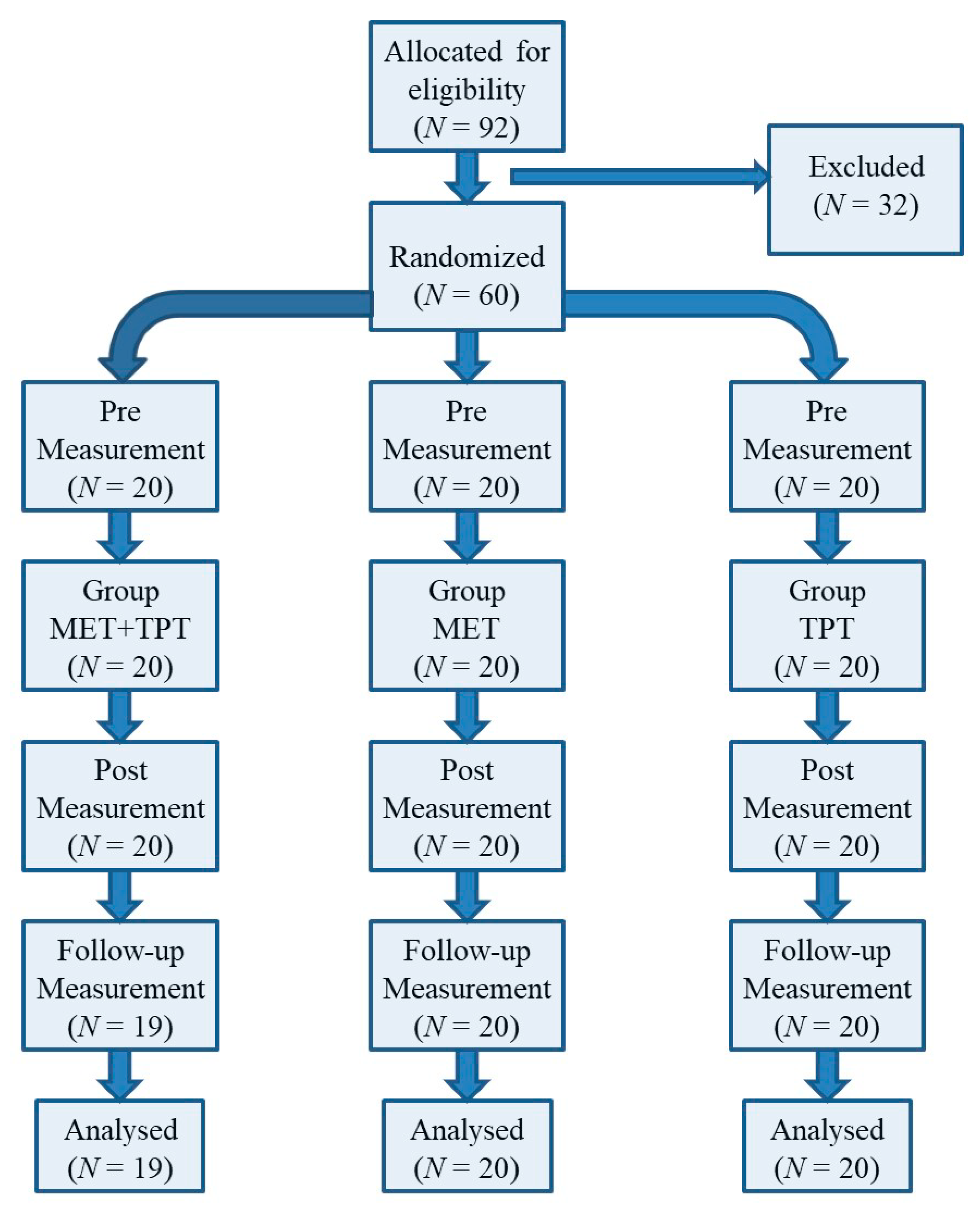
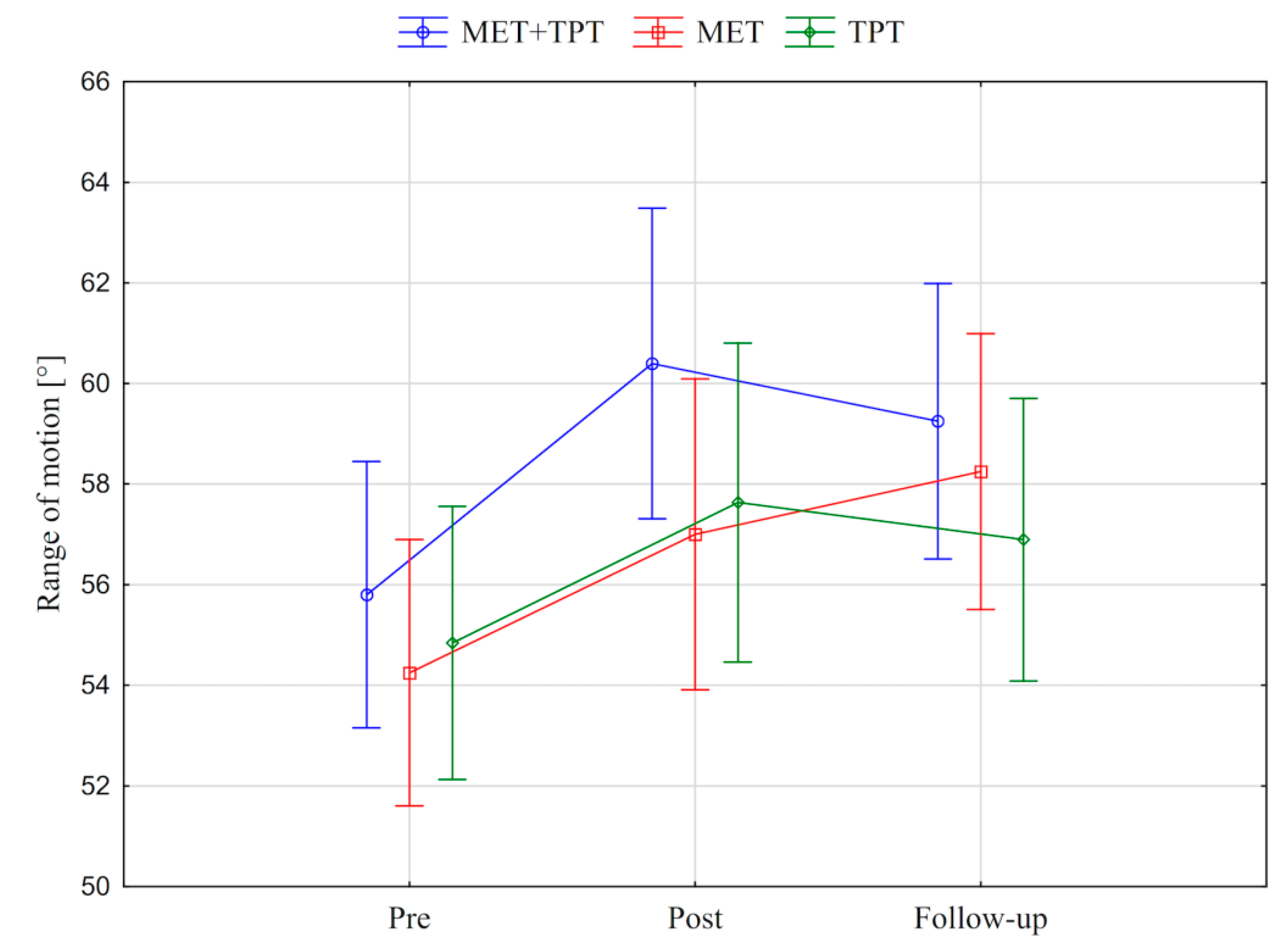
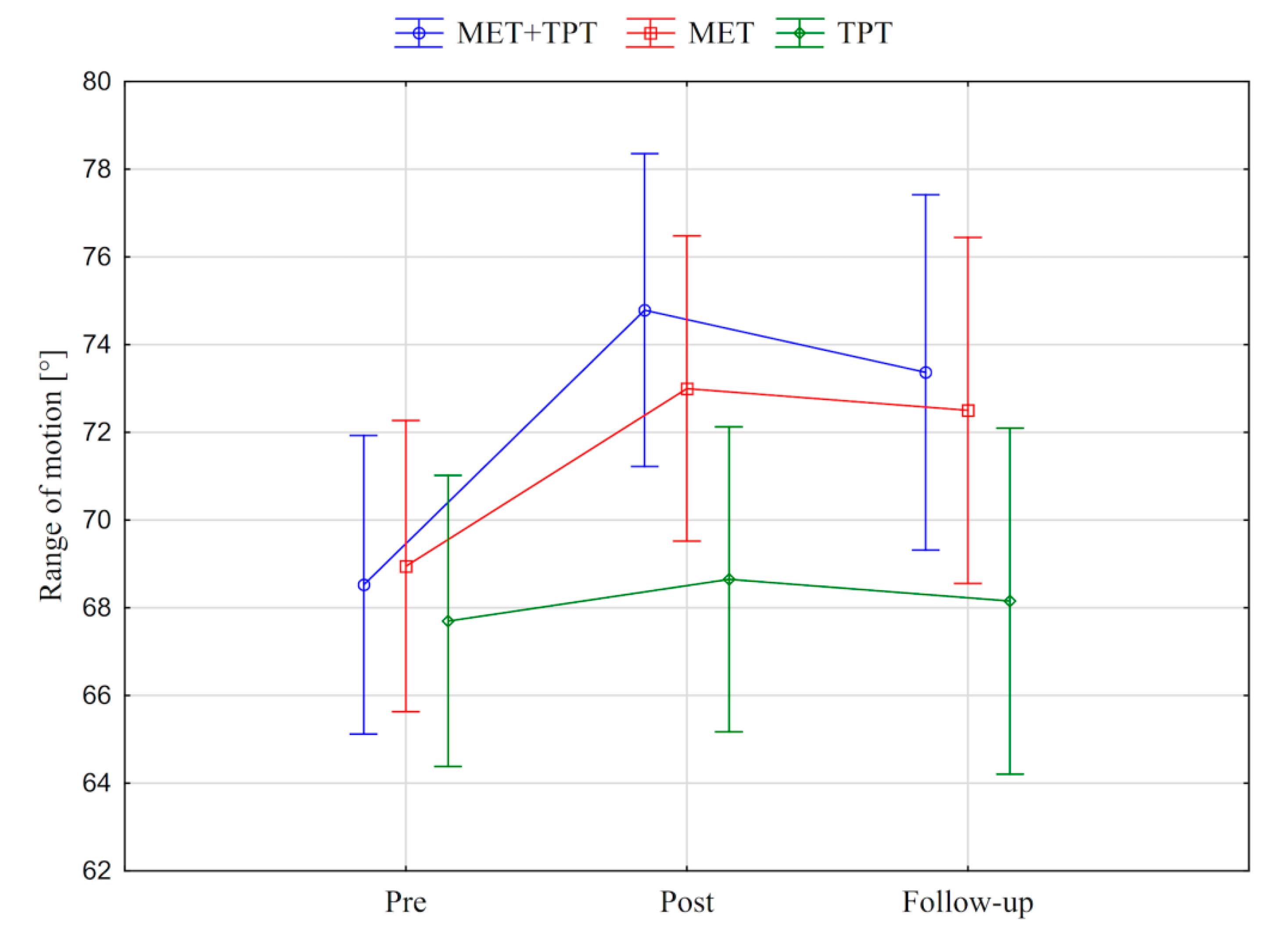
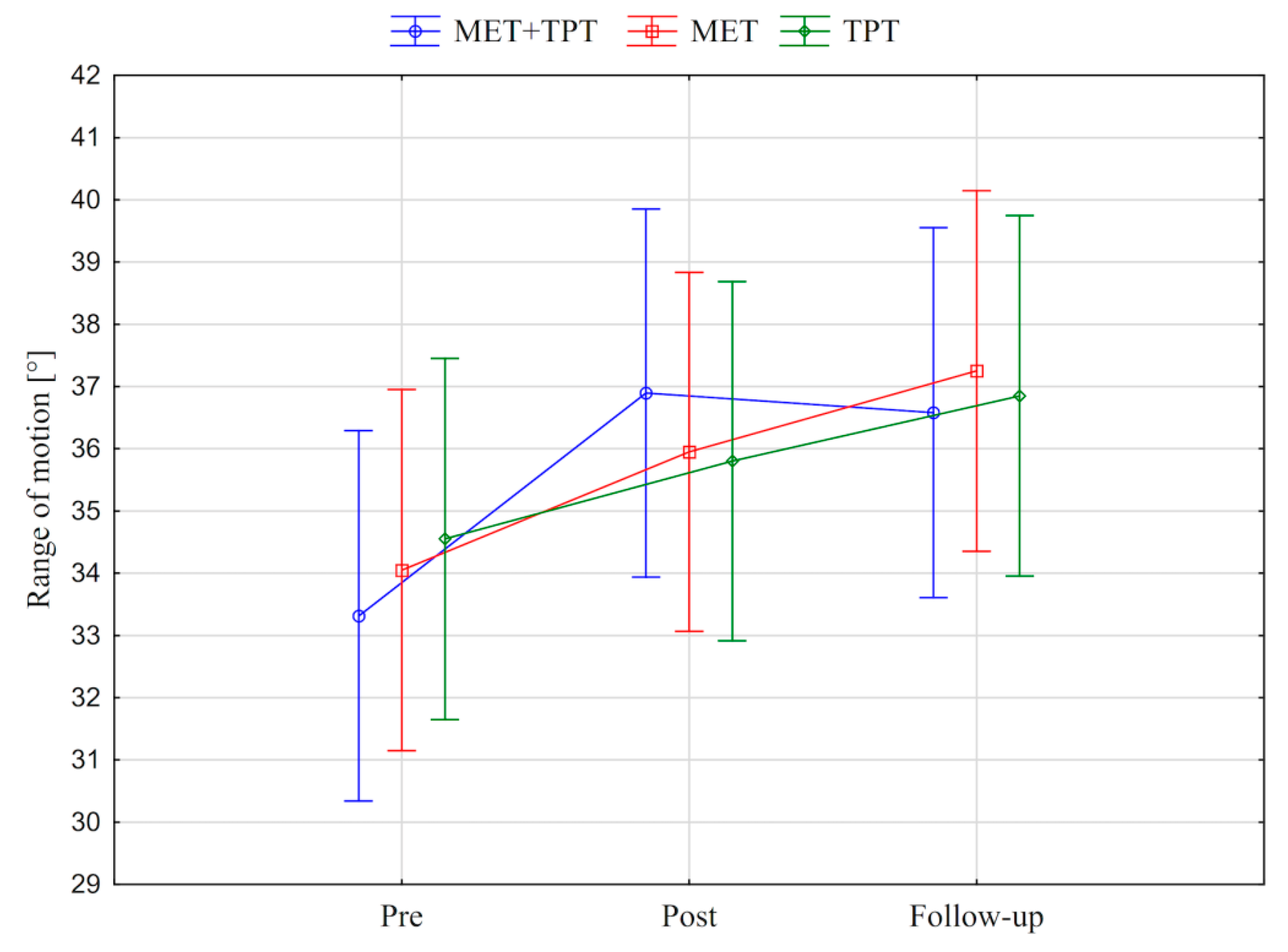
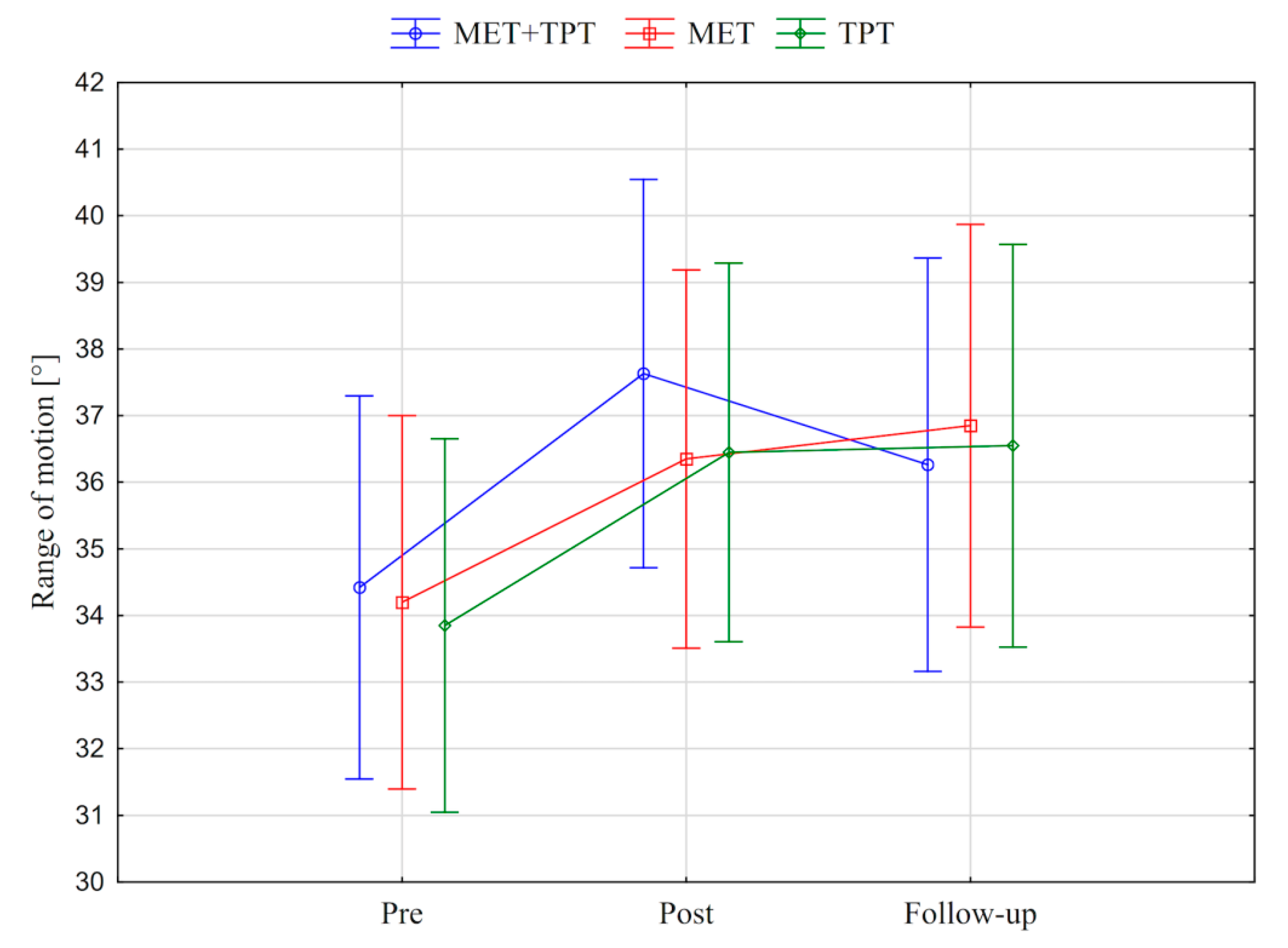
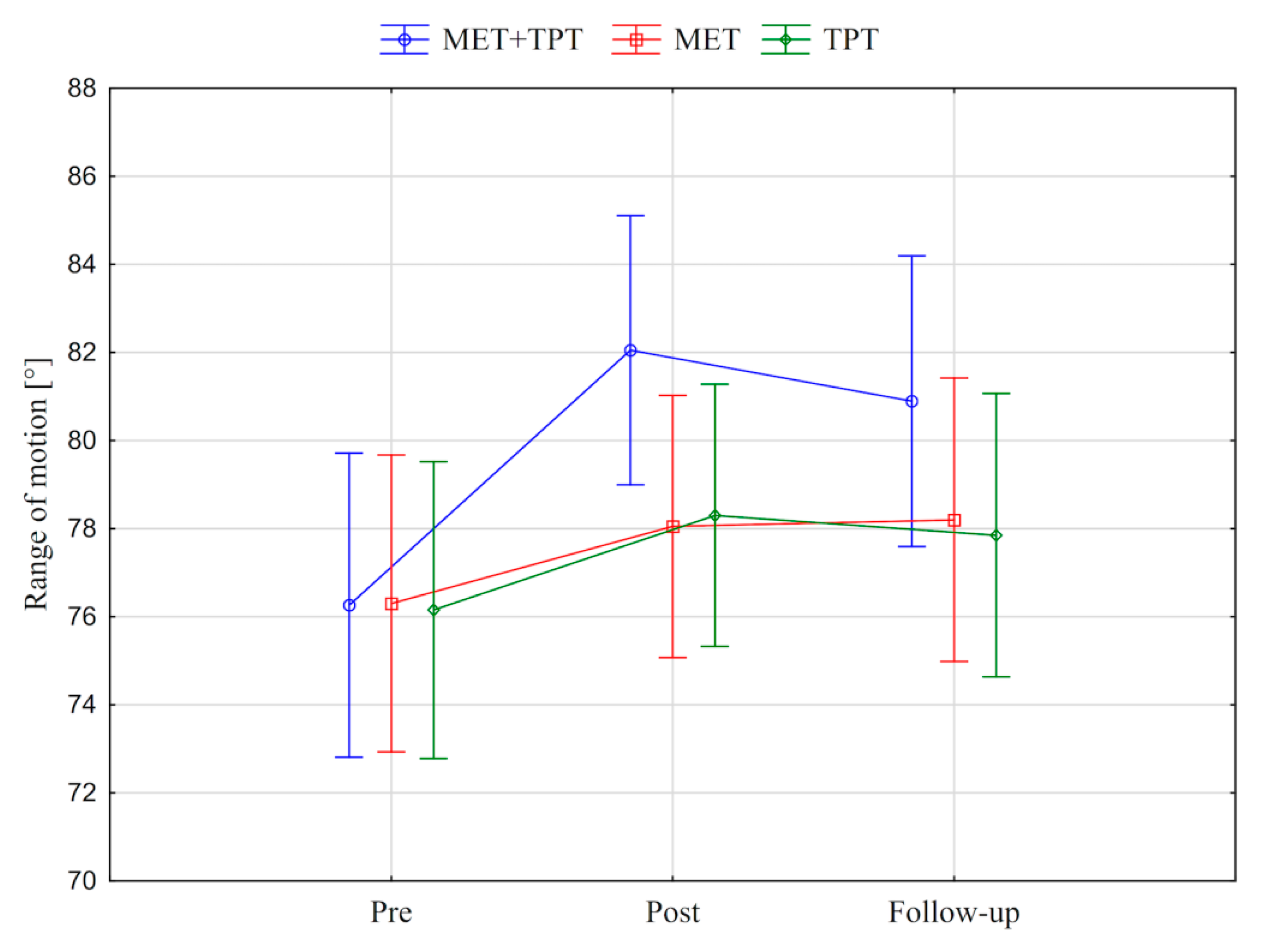
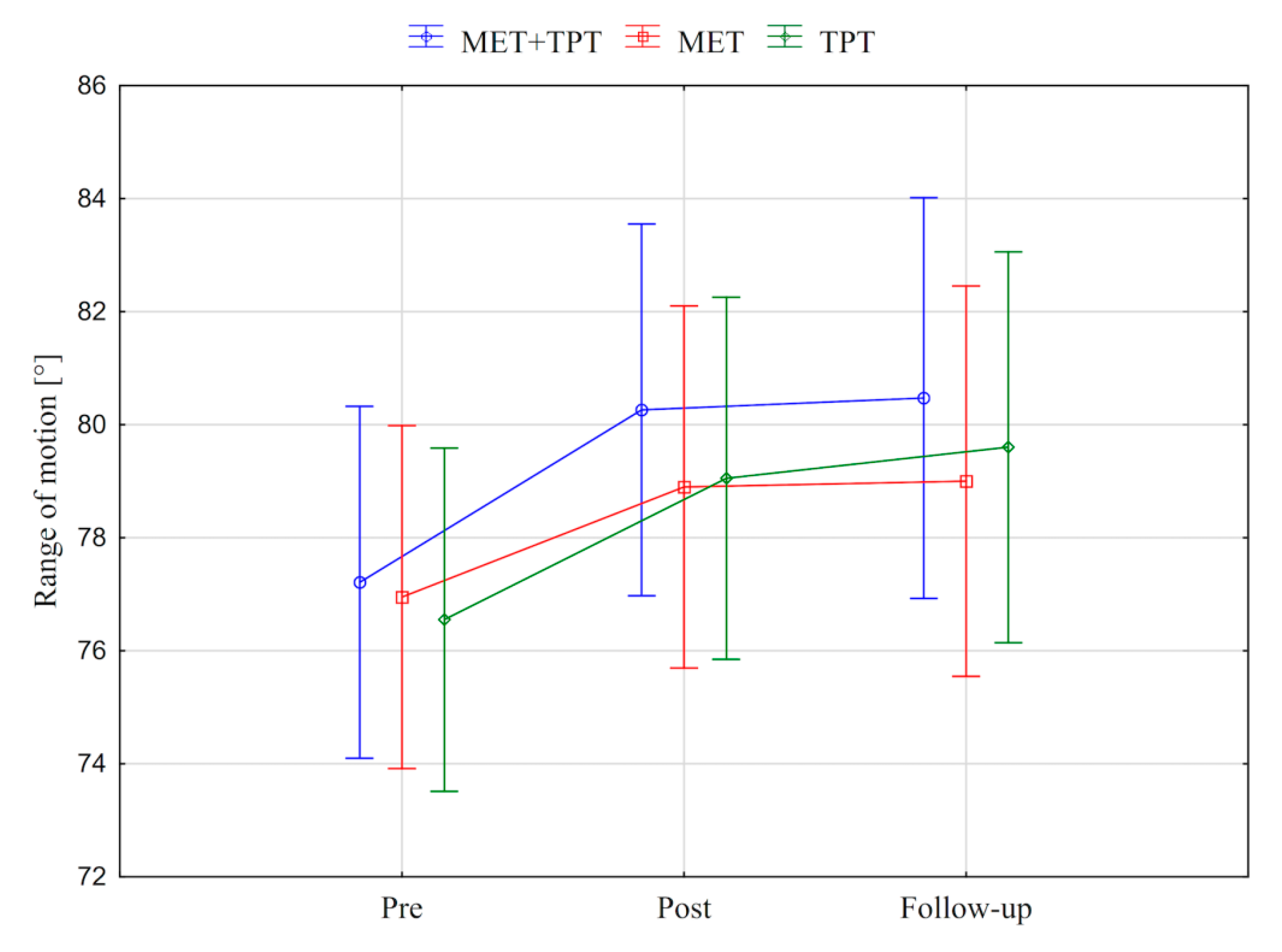
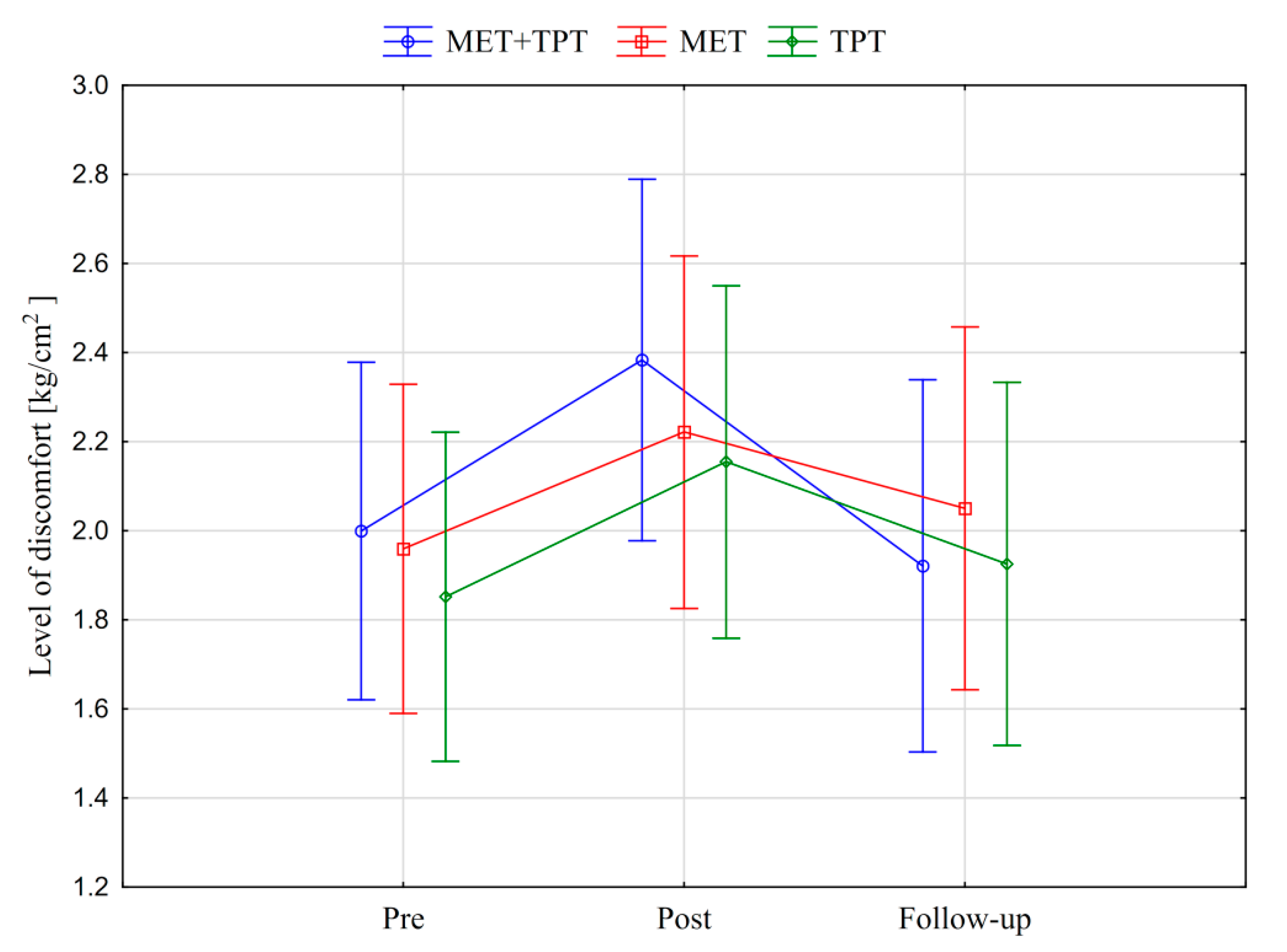
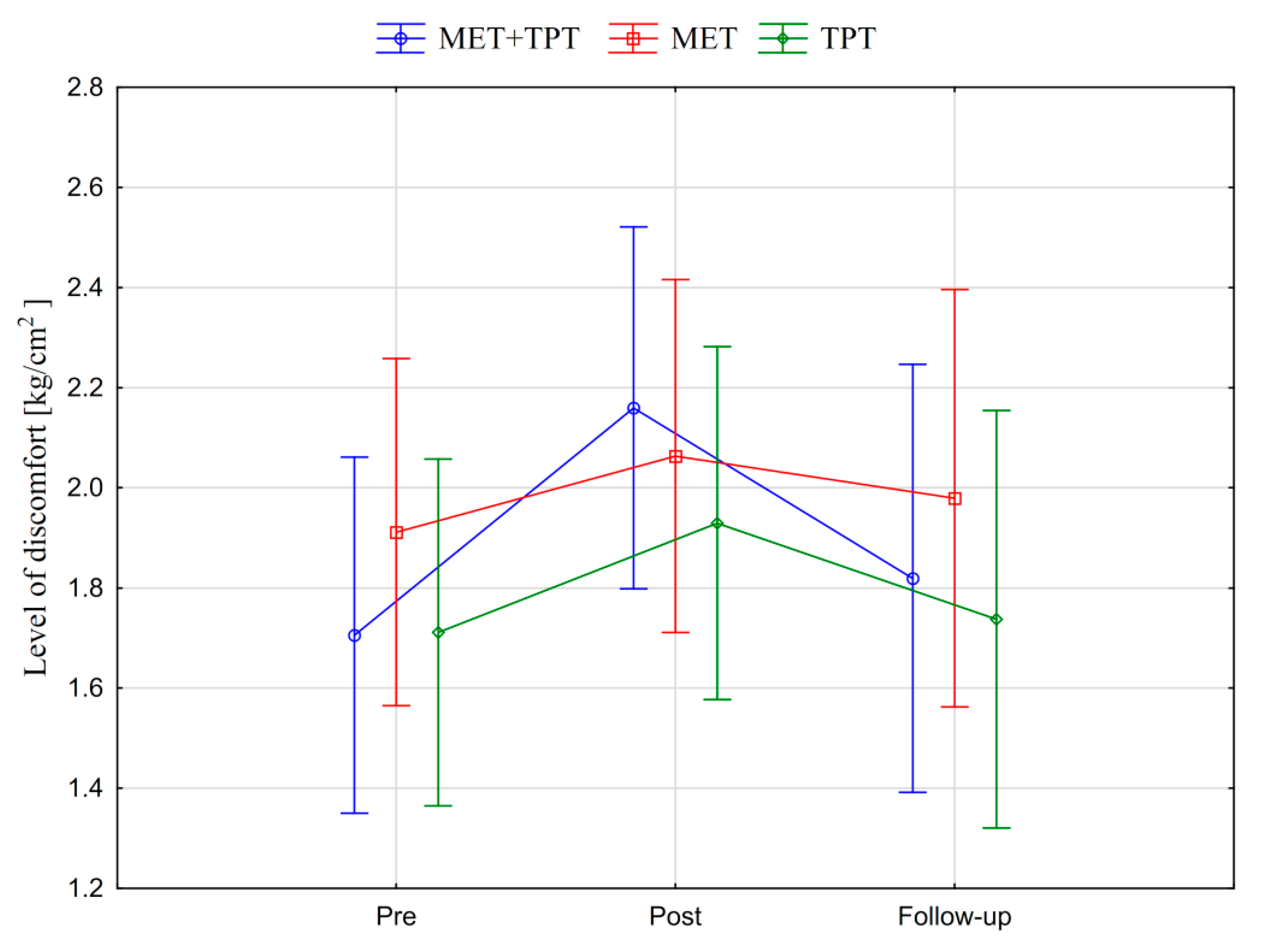
| Parameter | Category | Group MET + TPT | Group MET | Group TPT | |||
|---|---|---|---|---|---|---|---|
| N | % | N | % | N | % | ||
| Age (years) | 19 | 4 | 20 | 2 | 10 | 2 | 10 |
| 20 | 15 | 75 | 16 | 80 | 17 | 85 | |
| 21 | 1 | 5 | 2 | 10 | 1 | 5 | |
| Gender | men | 10 | 50 | 12 | 60 | 14 | 70 |
| women | 10 | 50 | 8 | 40 | 6 | 30 | |
| Weight (kg) | 60–70 | 7 | 35 | 8 | 40 | 6 | 30 |
| 71–80 | 7 | 35 | 8 | 40 | 7 | 35 | |
| 81–90 | 4 | 20 | 3 | 15 | 5 | 25 | |
| 91–100 | 2 | 10 | 1 | 5 | 2 | 10 | |
| Height (cm) | 160–170 | 6 | 30 | 6 | 30 | 5 | 25 |
| 171–180 | 9 | 45 | 11 | 55 | 10 | 50 | |
| 181–190 | 5 | 25 | 3 | 15 | 5 | 25 | |
| BMI(kg/m2) | 17–18.5 | 0 | 0 | 0 | 0 | 0 | 0 |
| 18.5–25 | 20 | 100 | 20 | 100 | 20 | 100 | |
| 25–30 | 0 | 0 | 0 | 0 | 0 | 0 | |
| Physical activity | 1× a week | 5 | 25 | 2 | 10 | 6 | 30 |
| 2× a week | 12 | 60 | 13 | 65 | 10 | 50 | |
| 3× a week | 3 | 15 | 5 | 25 | 4 | 20 | |
| Variable | Method (MET + TPT, MET, TPT) | R (Pre, Post, Follow-up) | R*Method | |||
|---|---|---|---|---|---|---|
| p | η2 | p | η2 | p | η2 | |
| CAF | 0.454 | 0.028 | 0.000 ** | 0.270 | 0.308 | 0.042 |
| CPF | 0.178 | 0.060 | 0.000 ** | 0.181 | 0.074 | 0.073 |
| CRF | 0.996 | 0.000 | 0.000 ** | 0.171 | 0.611 | 0.024 |
| CLF | 0.966 | 0.001 | 0.000 ** | 0.165 | 0.796 | 0.015 |
| CRR | 0.455 | 0.028 | 0.000 ** | 0.183 | 0.131 | 0.061 |
| CLR | 0.866 | 0.005 | 0.000 ** | 0.147 | 0.949 | 0.006 |
| Variable | MET + TP | MET | TP | |||||||||
|---|---|---|---|---|---|---|---|---|---|---|---|---|
| N | X | SD | p | N | X | SD | p | N | X | SD | p | |
| Cervical Anterior Flexion (CAF) | ||||||||||||
| Post–Pre | 20 | 4.60 | 3.44 | 0.000 ** | 20 | 2.75 | 4.06 | 0.007 * | 20 | 2.90 | 5.52 | 0.030 |
| Follow-up–Pre | 19 | 3.45 | 3.47 | 0.000 ** | 20 | 4.00 | 4.38 | 0.001 ** | 20 | 2.05 | 5.60 | 0.128 |
| Follow-up–Post | 19 | −1.15 | 3.39 | 0.146 | 20 | 1.25 | 4.41 | 0.220 | 20 | −0.74 | 5.63 | 0.575 |
| Cervical Posterior Flexion (CPF) | ||||||||||||
| Post–Pre | 20 | 6.65 | 5.81 | 0.000 ** | 20 | 4.05 | 6.53 | 0.012 * | 20 | 0.95 | 4.82 | 0.389 |
| Follow-up–Pre | 19 | 4.84 | 9.03 | 0.031 | 20 | 3.55 | 6.42 | 0.023 | 20 | 0.45 | 5.47 | 0.717 |
| Follow-up–Post | 19 | −1.42 | 5.84 | 0.303 | 20 | −0.5 | 5.22 | 0.673 | 20 | −0.50 | 4.96 | 0.657 |
| Cervical Right Flexion (CRF) | ||||||||||||
| Post-Pre | 20 | 3.65 | 4.40 | 0.002 ** | 20 | 1.90 | 5.98 | 0.172 | 20 | 1.25 | 3.32 | 0.109 |
| Follow-up–Pre | 19 | 3.26 | 6.36 | 0.038 | 20 | 3.20 | 6.48 | 0.040 | 20 | 2.30 | 3.51 | 0.009 * |
| Follow-up–Post | 19 | −0.32 | 3.68 | 0.713 | 20 | 1.30 | 4.93 | 0.253 | 20 | 1.05 | 3.94 | 0.248 |
| Cervical Left Flexion (CLF) | ||||||||||||
| Post-Pre | 20 | 3.35 | 3.54 | 0.001 ** | 20 | 2.15 | 6.83 | 0.175 | 20 | 2.60 | 2.39 | 0.000 ** |
| Follow-up–Pre | 19 | 1.84 | 3.47 | 0.033 | 20 | 2.65 | 6.26 | 0.074 | 20 | 2.70 | 4.09 | 0.008 * |
| Follow-up–Post | 19 | −1.37 | 3.90 | 0.144 | 20 | 0.50 | 6.09 | 0.718 | 20 | 0.10 | 4.39 | 0.920 |
| Cervical Right Rotation (CRR) | ||||||||||||
| Post-Pre | 20 | 5.45 | 6.30 | 0.001 ** | 20 | 1.75 | 4.88 | 0.125 | 20 | 2.15 | 4.09 | 0.030 |
| Follow-up–Pre | 19 | 4.63 | 6.18 | 0.004 * | 20 | 1.90 | 4.91 | 0.100 | 20 | 1.70 | 7.20 | 0.305 |
| Follow-up–Post | 19 | −1.16 | 5.88 | 0.402 | 20 | 0.15 | 3.18 | 0.835 | 20 | −0.45 | 4.47 | 0.657 |
| Cervical Left Rotation (CLR) | ||||||||||||
| Post–Pre | 20 | 2.95 | 5.03 | 0.017 * | 20 | 1.95 | 3.55 | 0.024 | 20 | 2.50 | 3.46 | 0.004 * |
| Follow-up–Pre | 19 | 3.26 | 5.85 | 0.026 | 20 | 2.05 | 6.18 | 0.154 | 20 | 3.05 | 5.43 | 0.021 |
| Follow-up–Post | 19 | 0.21 | 5.92 | 0.879 | 20 | 0.10 | 6.55 | 0.946 | 20 | 0.55 | 5.26 | 0.645 |
| Variable | Analysis of Variance | |||
|---|---|---|---|---|
| F | df1 | df2 | p | |
| CAF (Pre) | 0.364 | 2 | 57 | 0.697 |
| CAF (Post) | 1.394 | 2 | 57 | 0.256 |
| CAF (Follow-up) | 0.726 | 2 | 56 | 0.488 |
| CPF (Pre) | 0.158 | 2 | 57 | 0.855 |
| CPF (Post) | 3.742 | 2 | 57 | 0.029 * |
| CPF (Follow-up) | 1.988 | 2 | 56 | 0.147 |
| CRF (Pre) | 0.208 | 2 | 57 | 0.813 |
| CRF (Post) | 0.175 | 2 | 57 | 0.840 |
| CRF (Follow-up) | 0.053 | 2 | 56 | 0.948 |
| CLF (Pre) | 0.016 | 2 | 57 | 0.984 |
| CLF (Post) | 0.135 | 2 | 57 | 0.874 |
| CLF (Follow-up) | 0.037 | 2 | 56 | 0.964 |
| CRR (Pre) | 0.062 | 2 | 57 | 0.940 |
| CRR (Post) | 2.699 | 2 | 57 | 0.076 |
| CRR (Follow-up) | 1.039 | 2 | 56 | 0.361 |
| CLR (Pre) | 0.172 | 2 | 57 | 0.843 |
| CLR (Post) | 0.407 | 2 | 57 | 0.668 |
| CLR (Follow-up) | 0.179 | 2 | 56 | 0.836 |
| Method | LSD Test; Variable: CPF (Post) The Marked Differences Are Significant from p < 0.05 | ||
|---|---|---|---|
| MET + TPT | MET | TPT | |
| X = 75.30 | X = 73.00 | X = 68.65 | |
| MET + TPT | 0.356 | 0.009 * | |
| MET | 0.356 | 0.084 | |
| TPT | 0.009 * | 0.084 | |
| Variable | Method (MET + TPT, MET, TPT) | R (Pre, Post, Follow-Up) | R*Method | ||||
|---|---|---|---|---|---|---|---|
| p | η2 | p | η2 | p | η2 | ||
| PPT-right | 0.877 | 0.005 | 0.000 ** | 0.157 | 0.612 | 0.024 | |
| PPT-left | 0.735 | 0.011 | 0.001 ** | 0.126 | 0.440 | 0.033 | |
| Variable | MET + TPT | MET | TPT | |||||||||
|---|---|---|---|---|---|---|---|---|---|---|---|---|
| N | X | SD | p | N | X | SD | p | N | X | SD | p | |
| PPT-right trapezius muscle | ||||||||||||
| Post–Pre | 20 | 0.41 | 0.66 | 0.012 * | 20 | 0.26 | 0.32 | 0.002 ** | 20 | 0.30 | 0.41 | 0.004 * |
| Follow-up–Pre | 19 | −0.08 | 0.87 | 0.699 | 20 | 0.09 | 0.48 | 0.405 | 20 | 0.07 | 0.67 | 0.629 |
| Follow-up–Post | 19 | −0.46 | 0.71 | 0.011 * | 20 | −0.17 | 0.50 | 0.143 | 20 | −0.23 | 0.50 | 0.053 |
| PPT-left trapezius muscle | ||||||||||||
| Post–Pre | 20 | 0.47 | 0.44 | 0.000 ** | 20 | 0.15 | 0.33 | 0.050 | 20 | 0.22 | 0.46 | 0.047 |
| Follow-up–Pre | 19 | 0.11 | 0.65 | 0.455 | 20 | 0.07 | 0.43 | 0.487 | 20 | 0.03 | 0.72 | 0.871 |
| Follow-up–Post | 19 | −0.34 | 0.72 | 0.054 | 20 | −0.08 | 0.47 | 0.433 | 20 | −0.19 | 0.56 | 0.141 |
| Variable | Analysis of Variance | |||
|---|---|---|---|---|
| F | df1 | df2 | p | |
| Right trapezius muscle | ||||
| PPT (Pre) | 0.147 | 2 | 57 | 0.864 |
| PPT (Post) | 0.379 | 2 | 57 | 0.686 |
| PPT (Follow-up) | 0.128 | 2 | 56 | 0.880 |
| Left trapezius muscle | ||||
| PPT (Pre) | 0.454 | 2 | 57 | 0.638 |
| PPT (Post) | 0.524 | 2 | 57 | 0.595 |
| PPT (Follow-up) | 0.349 | 2 | 56 | 0.707 |
Publisher’s Note: MDPI stays neutral with regard to jurisdictional claims in published maps and institutional affiliations. |
© 2020 by the authors. Licensee MDPI, Basel, Switzerland. This article is an open access article distributed under the terms and conditions of the Creative Commons Attribution (CC BY) license (http://creativecommons.org/licenses/by/4.0/).
Share and Cite
Wendt, M.; Waszak, M. Evaluation of the Combination of Muscle Energy Technique and Trigger Point Therapy in Asymptomatic Individuals with a Latent Trigger Point. Int. J. Environ. Res. Public Health 2020, 17, 8430. https://doi.org/10.3390/ijerph17228430
Wendt M, Waszak M. Evaluation of the Combination of Muscle Energy Technique and Trigger Point Therapy in Asymptomatic Individuals with a Latent Trigger Point. International Journal of Environmental Research and Public Health. 2020; 17(22):8430. https://doi.org/10.3390/ijerph17228430
Chicago/Turabian StyleWendt, Michał, and Małgorzata Waszak. 2020. "Evaluation of the Combination of Muscle Energy Technique and Trigger Point Therapy in Asymptomatic Individuals with a Latent Trigger Point" International Journal of Environmental Research and Public Health 17, no. 22: 8430. https://doi.org/10.3390/ijerph17228430
APA StyleWendt, M., & Waszak, M. (2020). Evaluation of the Combination of Muscle Energy Technique and Trigger Point Therapy in Asymptomatic Individuals with a Latent Trigger Point. International Journal of Environmental Research and Public Health, 17(22), 8430. https://doi.org/10.3390/ijerph17228430





